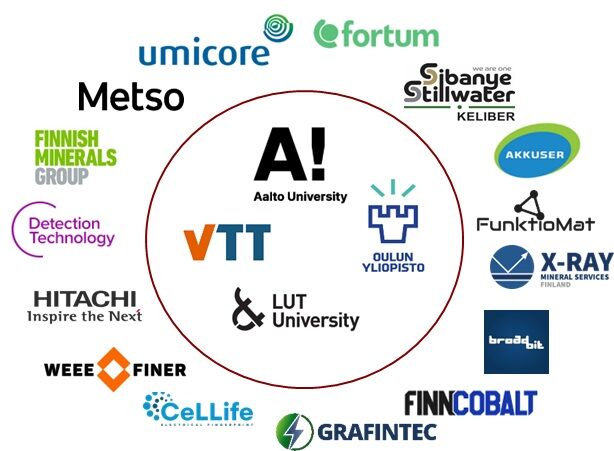About

BATCircle3.0 - Joint industry-academia project
- 4 research organizations
- 3 universities
- 1 research center
- 15 companies
- 7 large companies
- 8 small and medium-sized enterprises
- €13.4M total budget
- granted by Business Finland
- three years
The BATCircle3.0 ecosystem consists of key Finnish research and industrial actors involved in the battery metals sector. The ecosystem comprises three universities (Aalto University, University of Oulu, LUT University), one research centre (VTT), seven large and eight small or medium size companies (see full list of project members below) with a total budget of €13.4M. The BATCircle3.0 ecosystem has been formed under Business Finland's “Batteries from Finland” programme. The cooperation effort is expected to lead to the formation of a domestic battery metals ecosystem that follows the principles of circular economy.
Key topics
Battery chemistries are ever-evolving and becoming more complex over time. This is an inevitable development, as innovations are necessary to improve the performance of future batteries further. Radical shifts in the field could unleash significant economic potential for those who dare get involved early.
Recycling processes must also evolve with the changing world, as new chemistries complicate the material feed. Often, extensive effort is required to produce commercial-grade products from complex raw materials, which is no different for battery recycling. From a closed-loop point of view, it is imperative to get ahead of the curve when it comes to changing feed compositions in battery recycling.
Research efforts in this area catalyze the transition of the Finnish battery ecosystem to the next generation of battery materials. Essentially, the focus is on synthesizing cobalt-free precursors from recycled batteries, creating battery materials of the future, integrating their recycling into existing processes, and developing more accurate material testing methods.
Synthesizing new products from recycled materials is tricky. Companies running recycling processes seldom have the privilege of knowing exactly what type of input they are receiving at any given time. Unlike in primary production, where concentrates are well-analyzed and blending can be used to mitigate fluctuations in the feed, recycled streams are more heterogeneous due to the vast number of different types of batteries in circulation, which complicates the production of pure precursor chemicals.
To synthesize well-performing new batteries from recycled ones, ways to purify the recycled feed and the effect of impurities on the products must be studied. Under this topic, the research aims to answer these questions. Improving the recycling efficiency of under-recovered elements and developing new recycling mhethods are also in the scope of this work package.
Battery recycling is not a purely standalone industry but a part of the broader chemical and metallurgical complex. Just like metallurgical processes benefit from being intertwined, integrating battery recycling with existing chemical processes presents synergistic opportunities. Sustainability and minimization of waste are essential topics when considering new processing routes, and comparably, the impact of introducing new raw materials to old processes must be considered beforehand.
This area focuses on synergistic recycling, sustainability of battery materials processing, and improving material efficiency through better chemical circulation in the processes.

Project members and roles
Open research in BATCircle3.0 is conducted by academic partners, while confidential research is undertaken in company-specific R&I projects. A key objective of the BATCircle projects is to find ways to add value to the battery metals sector and strengthen collaboration between companies and research organizations. This will be achieved by more efficient screening and utilization of the domestic mineral resources, enhancement of the metal refining processes, more efficient recycling of battery metals, improved cooperation between the companies and research organizations, and identification of new business opportunities between partners.
BATCircle3.0 also has an Advisory board, which is an extended network of national and international stakeholders interested in ecosystem activities. The Advisory board members are annually invited to open seminars and receive news from the ecosystem and other activities ongoing in Finland.
Members of BATCircle3.0 are tightly involved in EU-level decision-making and other activities at different levels. For example, Aalto University is heading the Working Group 2 of ETIP Batteries Europe, “Raw materials and recycling”. Company members Fortum, Keliber and Terrafame have participated in an Important Project of Common European Interest (IPCEI). Additionally, Aalto University, GTK, VTT, University of Oulu, Finnish Minerals Group, Fortum and Metso Outotec are represented in the Batteries European Partnership Association (BEPA).

Consortium
Research organizations
Aalto University | LUT University
University of Oulu | VTT Technical Research Centre of Finland
Large companies (IND)
Umicore Battery Materials Finland | Finnish Minerals Group
Fortum Battery Technologies | Metso | Keliber Technology
Hitachi High Tech Analytical Science Finland | Detection Technology
Small and medium-sized enterprises (SMEs)
AkkuSer | BroadBit | Grafintec
FinnCobalt | FunktioMat | CeLLife Technologies
WeeeFiner | X-Ray Mineral Services
Advisory board
AaltoECS | AaltoDIEM | Aurubis | Akkukierrätys Pb | Bamomas | Boliden | CLIC Innovation | CNGR Finland | EIT InnoEnergy | EIT RawMaterials | Ethica | Glencore Nikkelverk | Hycamite | Kemira | Koppers | Linde Gas | Mitsubishi Corporation | Primobius | Recser | SAMK | Sensmet | Shift Materials | Spinverse | Stora Enso | Tracegrow | University of Vaasa | Veolia | Worley

